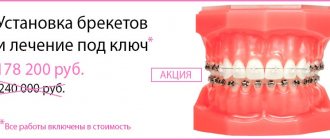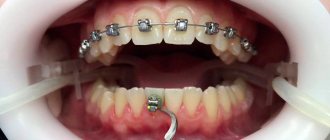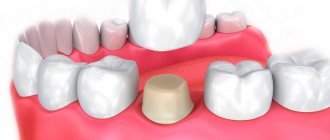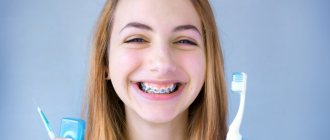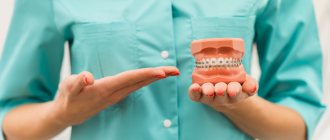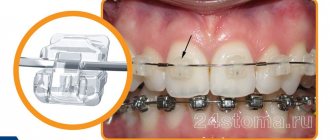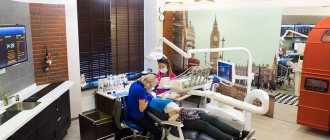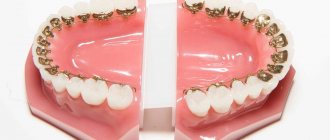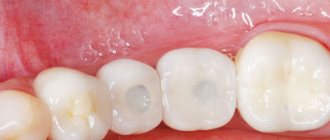Hi all! My name is Sakadynets Alexander, I have been practicing for 12 years and the number of my patients has exceeded 1000. Very often I hear repeated questions from my patients, and I understand how little quality information there is on the Internet and other sources. Sometimes the questions are logical, sometimes they are formed from incorrect information taken from various sources. Alas, myths and prejudices regarding braces still exist in society: supposedly braces contribute to the development of oral diseases, treatment with braces is painful, braces are created only for people under 18 years of age, etc. So, it’s time to collect all these questions in a bunch and try to give explanatory answers to them. I would like to note right away that not a single article can replace a live consultation with a doctor; it is for general informational purposes only.
I want braces on one jaw!
Quite a tempting option for many. But it should be understood that the answer lies already in the name “bracket-SYSTEM”, which implies the SYSTEMIC work of the orthodontic apparatus. And initially, such a decision may be completely wrong, and the amount saved will no longer be so, because all the treatment, and most importantly - time, will go down the drain.
Why?
It's all about the relationship between the upper and lower jaws: when one row of teeth moves, the other follows. And the conclusion from this is the following: braces are not installed with the aim of “straightening” some teeth. The braces system helps to change the position of the dentition in order to improve the bite! Simply put, a proper bite is when one jaw fits over the other like the gears in a watch.
What happens while wearing braces on one jaw? While the system has moved the tooth in the desired direction, another row of teeth tries to move it back. However, in some cases, the option of installing braces on one jaw is acceptable. For example, if the bite is already correct, but there is symmetry of the jaws. Or when connecting another jaw is necessary based on the patient’s clinical case.
Photo while wearing braces
Photo after wearing braces
Reasons for the appearance of distal bite, why it is dangerous
The causes of the defect may be genetic disorders, especially in cases where relatives had a similar diagnosis.
Sometimes the occurrence of pathology is facilitated by a lack of nutrients, microelements, as well as bad habits.
– sucking toys, pacifiers.
Often, instead of a pacifier, the child uses a finger to suck
- which undoubtedly contributes to the development of distal occlusion:
The structure of the dental apparatus is disrupted in the presence of untreated diseases of the nasopharynx - breathing through the mouth provokes weakening of muscles, ligaments and jaws shift.
Correction of distal bite with braces is necessary. If you ignore pathology, you will have to overcome many problems.
Problems arising from distal occlusion:
- Diction is broken.
- There is no adequate chewing of food, not all foods are convenient to eat. Gastrointestinal ailments or somatic diseases develop.
- It is difficult to get dentures in the future.
- Uneven load often leads to loosening of units and destructive changes in tissues.
The dentist will make an initial conclusion during the first examination and order imaging to clarify the diagnosis.
Will braces ruin my teeth?
Let me say right away that braces do not damage your teeth. But only subject to hygiene rules and doctor’s recommendations. But here it is better to dispel several myths at once:
No. 1 Teeth under braces will definitely deteriorate
Nothing exactly happens under the braces, but the whole problem usually occurs around the braces - if the patient does not brush his teeth after every meal, then caries forms as a result.
Or if the patient has a strong tendency to form plaque (in this case, hygiene should be more careful). But if the patient could not agree on hygiene during treatment, then I usually suggest, and sometimes insist, that the orthodontic treatment be completed.
No. 2: The enamel may come off along with the braces.
When removing the braces, the doctor leaves some of the glue on the tooth, which is then easily removed with a bur, and then the teeth are polished. In this case, the enamel remains intact and unharmed.
#3: Teeth may fall out after braces.
Basically, patients understand that after proper treatment this is in no way possible. Mobility of teeth during treatment with braces - this happens, and this is normal (after all, teeth move, and this is quite logical). Retention, consisting of both removable and non-removable devices (retainers, mouth guards, plates), will help maintain the position of teeth after treatment, which will help keep the teeth in their correct position.
MATERIAL FOR MANUFACTURING ORTHODONTIC SYSTEMS
The choice of material for orthodontic structures is quite wide:
- metal;
- plastic;
- ceramics;
- dental sapphire.
Metal ones are the cheapest. Metal braces look scary, but they are one of the best in terms of treatment effectiveness. The metal does not stain when worn, does not bend or break.
Patients try to choose inconspicuous structures made of plastic/ceramics/sapphire for the upper jaw. However, everything has its own characteristics. For example, plastic braces begin to turn yellow over time and may not withstand the load - they break. Such designs can be worn for no more than six months with a slight curvature of the row.
Ceramics are more resistant to stress compared to plastic. Ceramic braces can be almost invisible if the color of the material is matched to the tone of the enamel. Sapphire braces are made from a special crystal grown under certain conditions. Such hardware structures are not inferior in strength to metal ones and are not noticeable. The whole issue is the high price.
What is a good orthodontist?
Personally, I am always in favor of the patient receiving at least two third-party opinions. Orthodontic treatment must be approached very seriously, because you are committed to a relationship with the doctor for 1-2 years (or even more). Without mutual understanding, orthodontic treatment is doomed! There are several most important criteria when choosing a doctor:
- High-quality collection of information/diagnostic data
The doctor must make impressions, then carry out calculations on the models, study the OPTG image or CBCT (3-D image), and take intraoral photographs. ONLY after this can you begin treatment with the bracket system. Taking photographs is also a very important diagnostic step.
- Reviews and reputation
I won’t say obvious things here, but it’s worth paying more attention to the doctor’s actual work, rather than reviews on his personal page. By the way, negative reviews are often really unsolicited, but they can be found for literally every doctor (even the best of the best), so filter the information received. Well, no one canceled the recommendations of friends.
- Availability of diplomas/certificates
Having certificates is far from an empty phrase. This suggests that the doctor wants to develop in his field and know about new developments in the field of medicine. Do not hesitate to ask questions about where the doctor received his knowledge, practice, etc.
- Employment
Sometimes we have to work quickly, on the fly. But alas, the case is not always immediately clear. And in general, orthodontics is a science where you need to think a lot. After all, bite alignment is a kind of arcade game for the doctor. Just clarify what the doctor's plans are for you and make sure that the doctor treats your case carefully.
Orthodontists KANO
BIBLIOGRAPHY
1. Sarver, D.: Interactions of hard tissues, soft tissues, and growth over time, and their impact on orthodontic diagnosis and treatment planning, Am. J. Orthod. 148:380–386, 2015. 2. Sarver, D. and Jacobson, R.S.: The aesthetic dentofacial analysis, Clin. Plast. Surg. 34:369-394, 2007. 3. Peck, H. and Peck, S.: A concept of facial esthetics, Angle Orthod. 40:284-318, 1970. 4. Schabel, BJ; McNamara, J. A. Jr.; Baccetti, T.; Franchi, L.; and Jamieson, SA: The relationship between posttreatment smile esthetics and the ABO Objective Grading System, Angle Orthod. 78:579-584, 2008. 5. Kokich, V.O.; Kiyak, A.H.; and Shapiro, PA: Comparing the perception of dentists and laypeople to altered dental esthetics, J. Esth. Dent. 11:311-324, 1999. 6. Kokich, V.O.; Kokich, V. G.; and Kiyak, H.A.: Perceptions of dental professionals and laypersons to altered dental esthetics: Asymmetric and symmetrical situations, Am. J. Orthod. 130:141- 151, 2006. 7. Auger, T. A. and Turley, P. K.: The female soft tissue profile as presented in fashion magazines during the 1900s: A photographic analysis, Int. J. Adult Orthod. Orthog. Surg. 14:7-18, 1999. 8. Schlosser, JB; Preston, C. B.; and Lampasso J.: The effects of computer-aided anteroposterior maxillary incisor movement on ratings of facial attractiveness, Am. J. Orthod. 127:17-24, 2005. 9. Desai, S.; Upadhyay, M.; and Nanda, R.: Dynamic smile analysis: Changes with age, Am. J. Orthod. 136:310.e1-310.e10, 2005. 10. Dickens, S.; Sarver, D. M.; and Proffit, W.R.: The dynamics of the maxillary incisor and the upper lip: A cross-sectional study of resting and smile hard tissue characteristics, Am. J. Orthod. 3:313-320, 2002. 11. Chetan, P.; Tandon, P.; Singh, G. K.; Nagar, A.; Prasad, V.; and Chugh, V.: Dynamics of a smile in different age groups, Angle Orthod. 83:90-96, 2013. 12. Beall, AE: Can a new smile make you look more intelligent and successful? Dent. Clin. N. Am. 51:289-297, 2007. 13. Shaw, W. C.; Rees, G.; Dawe, M.; and Charles, C.R.: The influence of dentofacial appearance on the social attractiveness of young adults, Am. J. Orthod. 87:21-26, 1985. 14. Tjan, A.H.; Miller, G.D.; and The, JG: Some esthetic factors in a smile, J. Prosth. Dent. 51:24-28, 1984. 15. Sabri, R.: The eight components of a balanced smile, J. Clin. Orthod. 39:155-167, 2005. 16. Hulsey, C.: An esthetic evaluation of lip-teeth relationships present in the smile, Am. J. Orthod. 57:132-144, 1970. 17. Ackerman, J.; Ackerman, M. B.; Brensinger, C. M.; and Landis, JR: A morphometric analysis of the posed smile, Clin. Orthod. Res. 1:2-11, 1998. 18. Pitts, T.: Bracket positioning for smile arc protection, J. Clin. Orthod. 51:142-156, 2021. 19. Proffit, W.R.; Fields, H. W.; Larson, B.; and Sarver, DM: Contemporary Orthodontics, 6th ed., Elsevier, Philadelphia, 2021, p. 160.20. Dickens, S. T.; Sarver, D. M.; and Proffit, W.R.: Changes in frontal soft tissue dimensions of the lower face by age and gender, World J. Orthod. 3:313-320, 2002. 21. Harris, E.F.; Hassankiadeh, S.; and Harris, JT: Maxillary incisor crown-root relationships in different angle malocclusions, Am. J. Orthod. 103:48-53, 1993. 22. Bryant, R. M.; Sadowsky, P.L.; Dent, M.; and Hazelrig, J.B.: Variability in three morphological features of the permanent maxillary central incisor, Am. J. Orthod. 86:25-32, 1984. 23. Van Loenen, M.; Degrieck, J.; De Pauw, G.; and Dermaut, L.: Anterior tooth morphology and its effect on torque, Eur. J. Orthod. 27:258–262, 2005. 24. Mavroskoufis, F. and Ritchie, G. M.: Variation in size and shape between left and right maxillary central incisor teeth, J. Prosth. Dent. 43:254-257, 1980. 25. Chaushu, S.; Sharabi, S.; and Becker, A.: Tooth size in dentitions with buccal canine ectopia, Eur. J. Orthod. 25:485-491, 2003. 26. Balut, N.; Klapper, L.; Sandrik, J.; and Bowman, D.: Variations in bracket placement in the preadjusted orthodontic appliance, Am. J. Orthod. 102:62-67, 1992.
I'm already old/too old for braces
In fact, today the framework in orthodontic treatment has been completely erased. Of course, each age has its own subtleties of work for a doctor. However, the result is always the same. And one more fact - people sometimes lose their teeth not because of caries and other dental problems, but because of an incorrect bite. When the load is distributed unevenly, it ultimately leads to bone loss and tooth wear.
I will not tire of repeating that we do straight teeth not only to solve aesthetic problems. Often this will save you from early tooth loss.
Signs of distal bite
Distal occlusion requires mandatory intervention from a specialist; treatment with braces is indicated; aligners can be used (especially when the diagnosis is made in childhood).
Signs of distal occlusion:
- The child spontaneously bites his lower lip
:
- The profile is slightly beveled. To define it, the term “avian” is used.
- The lips are thin and fall inside the oral cavity
. If you visually draw a line from the tip of the nose to the middle of the chin, then the lips will not appear on it:
- The lower third of the face is disproportionately small. A crease appears on the chin due to the jaw moving back.
It is possible to correct distal bite without braces when treatment is carried out in childhood. Aligners are approved for installation in children with baby teeth. They are installed in older preschool age, when the child can consciously follow the dentist’s recommendations.
In my practice, there are already more than 300 successful cases of bite correction using aligners. This is a promising method. Invisalign and FlexLiner aligners have proven themselves to be excellent in the treatment of distal occlusion. Star Smile aligners also correct this dental pathology quite well, although they require more careful attention from the attending physician. Whether correction of distal bite with aligners is right for you or your child can only be said with confidence during a consultation.
After getting braces, will I have to go on a strict diet?
Undoubtedly, there will be changes in diet, but they are absolutely not worth the fears associated with the myth that braces deprive you of gastronomic joys. You will just need to be more careful and exclude only some of the products (nuts, puffed rice, popcorn, caramel, nougat, seeds, chewing gum, etc.).
First of all, this is necessary in order not to clog the spaces between the grooves of the braces, where bacteria can accumulate and caries can develop. You should also avoid drinks with dyes, hot and cold drinks (temperature changes can cause the braces to come off).
Think for yourself, after all, braces are even a kind of motivation to start a healthy lifestyle, because it is mainly harmful foods that are excluded.
Eating while wearing braces
Is it possible to wear braces during pregnancy?
Modern braces are absolutely harmless to the body and do not cause allergies. Therefore, wearing them in itself does not in any way affect the course of pregnancy and the intrauterine development of the child. But this is subject to careful oral care! ⠀ Of course, hormonal imbalance affects the condition of the bone, but here it is necessary to conduct research from specialists and only after that decide whether treatment or continuation of treatment during pregnancy is possible. It is better to plan the installation of braces 1-2 months before pregnancy, so that all the necessary studies do not negatively affect the fetus (X-rays, CT scans, etc.). ⠀ According to experienced orthodontists, if a woman becomes pregnant, then there is no need to do anything special. It makes sense to wear braces until you finish breastfeeding, even if it is possible and will be for quite a long time. However, this will allow the bone tissue to normalize, and the woman will not miss out on the results of treatment already obtained before pregnancy. If you are pregnant or plan to become pregnant, be sure to talk to your doctor. Only a specialist will be able to correctly assess your condition and prescribe the necessary course of action!
Is it possible to treat teeth during pregnancy?
Life with braces on teeth: adaptation and care
The secret to the effectiveness of braces is the gradual movement of teeth at the level of the root system. The units move from the pathological position to the correct one, but this transition is associated with slight discomfort for the patient.
The sensations are especially unpleasant in the first days after activation: the teeth ache and even hurt. This is an adaptation period, and it lasts differently for children. Usually a week or two. Then the teeth get used to micro-movements, and the child stops feeling the braces in the mouth.
But the question of care remains open. The orthodontic design consists of many elements - with an abundance of niches, corners, and difficult-to-clean areas. Therefore, you have to devote a lot of time to caring for braces every day - 15-25 minutes twice a day. During the care process, teeth and system elements are cleaned one by one:
- orthodontic brush with V-shaped bristles;
- mono-beam brush;
- pipe cleaners;
- dental floss.
It is good to additionally use special toothpastes for patients with braces, an irrigator and a mouth rinse.
If everything is done correctly and according to the prescribed algorithms, then treatment with braces will not leave any unpleasant memories, and your teeth will acquire a straight and beautiful appearance.
Is it possible to do without retention and what is it even?
Retention is perhaps one of the most important parts of the entire treatment. Why? Teeth are harmful guys, and they will try to return to their original position, which is comfortable only for them. This is called a relapse. But neither I nor my patient want this. That’s why I really insist on retention, often even suggesting double retention.
What is retention? This is a removable or non-removable device designed to hold the dentition in the desired position. This could be a splint, a retainer (an arch behind the teeth), a night guard, or a plate.
Retainer after braces


